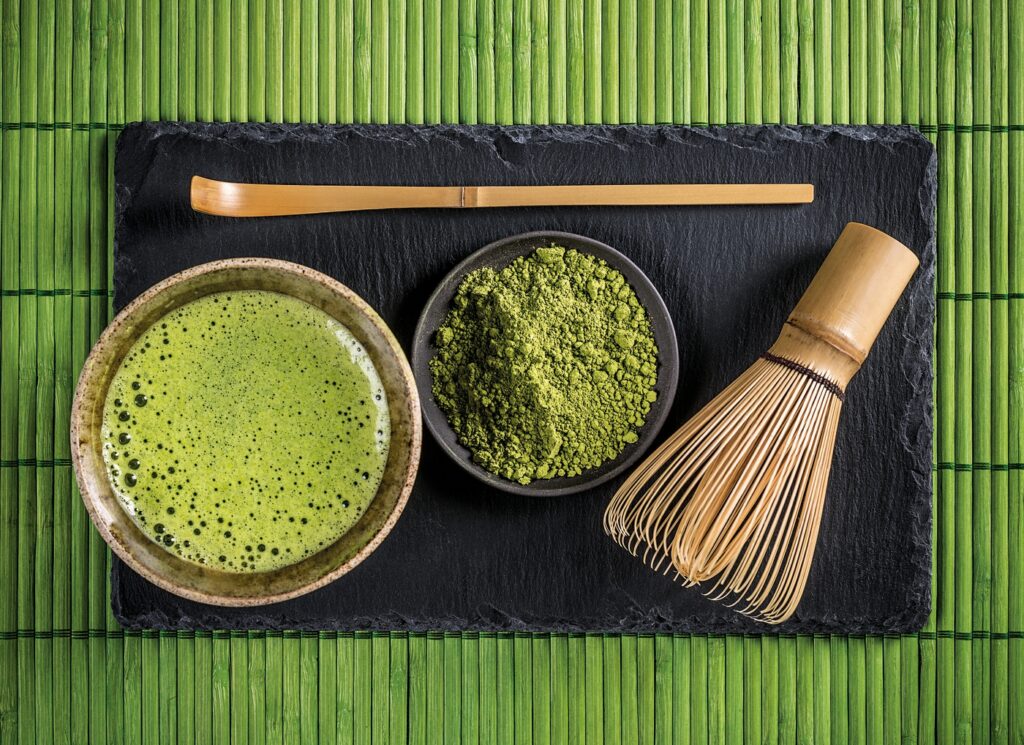Luxury food: Matcha tea

The Matcha tea is a fabulous and healthy drink produced in Japan that can be served on board Private Jets.
I remember one episode of my airline life, where I was flying from Seoul to Dubai. It was a night flight and not much to do. I was chatting with another crew member, a Japanese girl from Kyoto. She told me she has a sort of degree in the Japanese tea ceremony. How cool!
Years later, my mind went back to that memory, when my customer on board a Private Jet asked me for a Matcha tea for the first time.
This tea comes form the leafs of the plant named Camellia Sinensis and its leaves are grown in shade for 3 or 4 weeks before harvest. This process allows the plant to produce more theanine and caffeine.
Subsequently, the tea leaves are crashed into powder trough a granite stone mills. Combine then the matcha powder with, for example, water or milk.
Lower quality of matcha tea are used in the modern cuisine to dye or flavour asiatic food for example Japanese mochi, green tea ice cream, soba noodles, matcha latte. There are no standard definition for the requirements of the cuisine matcha powder.
Grades of matcha powder
Ceremonial Matcha is a specific ceremonial-grade powder. Means that the powder is of a high enough quality to use in the tea ceremony and Buddhist temples. It’s the most expensive quality and comes at the price of around 120€ for 50 grams.
Premium grade is high-quality matcha green tea that contains young tea leaves from the top of the tea plant. The price is around 70€ for 50 grams. This quality is the best for daily consumption.
The last grade is the cooking/culinary grade. This is the cheapest and comes at the price of 35€ for 50 grams.
How to prepare a matcha drink.
Mix Matcha powder in water or milk, both hot or cold. If hot, the water must be close to boiling point at 65 C to 80 C.
In both cases, the same quantity of powder is needed.
If you have a matcha tea-set on board the Private Jet, you can use the bamboo spoon you find in the set to calculate the correct amount.
Use the bamboo whisk called “chasen” to crash the lumps and allow the powder to melt. Do not use it in a circular motion, but “M” like motion instead. A sort of foam should appear at surface.
Serve it in the typical Japanese tea bowls or tea mugs.
If you don’t have a matcha tea-set, the correct quantity of powder is the tip of a knife. Something around 1.5 grams.
Because it takes time to melt, add water little by little and continue stirring.
Above all, famous tea-based drink on board Private Jet is matcha tea with almond milk and a spoon of honey. To be served lukewarm or cold with ice cubes in a tumbler glass.
Health properties
Reduces stress effects by suppressing adrenal hypertrophy. It contains antioxidant who are responsible to mildly prevent cancer, diseases, and help in weight loss.
Food pairing
Avocado toast, citrus salad and fresh fruit- pineapple in particular.
If you wish to match the matcha tea with local Japanese food items, consider to go for a Kaiseki, in other words, the traditional multi-course Japanese dinner.
Originally, this meal includes a bowl of miso soup as hot entree, followed by three dishes. Kaiseki has then evolved into a minimum of one appetiser, sashimi, a simmered dish, a grilled dish and a steamed course.
In addition and for a sweet end, Wagashi is a good dessert choice for Matcha tea. They are a sort of plant-based petit fours.